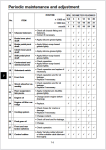Good day to all,
I recently purchased a '22 FJR with just under 11,000 miles. The previous owner took very good care of the bike but the only maintenance done so far has been engine oil/filter changes and final drive oil changes. Engine oil/filter was last changed at 10,500 miles and final drive oil was last changed at 6,800 miles so I figure those are fine for a while.
I normally take my bikes to the dealerships for service and I'm thinking I can hold off until 13,000 miles to do the 12,000 mile service since the previous owner has already done some important maintenance to the bike. Does this make sense to you more experienced FJR owners or do you think I should take it in for maintenance sooner? Also,what maintenance is most important during the 12,000 mile service or would you just tell the dealership to do what the periodic maintenance chart in the owner's manual says to do? Thanks in advance for any thoughts and advice.
I recently purchased a '22 FJR with just under 11,000 miles. The previous owner took very good care of the bike but the only maintenance done so far has been engine oil/filter changes and final drive oil changes. Engine oil/filter was last changed at 10,500 miles and final drive oil was last changed at 6,800 miles so I figure those are fine for a while.
I normally take my bikes to the dealerships for service and I'm thinking I can hold off until 13,000 miles to do the 12,000 mile service since the previous owner has already done some important maintenance to the bike. Does this make sense to you more experienced FJR owners or do you think I should take it in for maintenance sooner? Also,what maintenance is most important during the 12,000 mile service or would you just tell the dealership to do what the periodic maintenance chart in the owner's manual says to do? Thanks in advance for any thoughts and advice.







